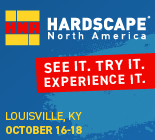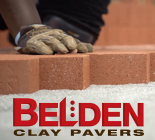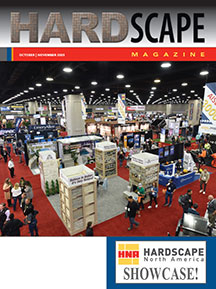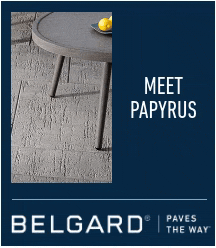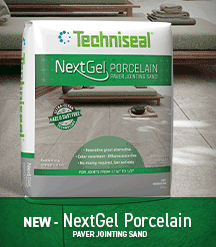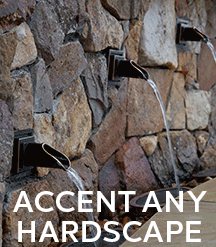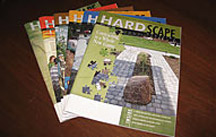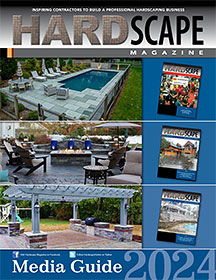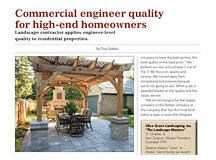Construction articles

Using concrete toe as edge restraint adds unnecessary risk to the success of a paver installation.
Why use concrete toe as edge restraint?
By Jay Krech, SEK-Surebond Director of Technical Support & TrainingThis industry has come a long way in the 40 years that I’ve been involved as an ICPI level 2 contractor, ICPI instructor and now as a technical trainer. The variety of high quality products, installation systems and training available today allows contractors to consistently build quality projects that will last for years.
With all the superior technology available today, I find it difficult to understand why so many contractors are still installing a troweled concrete toe as edge restraint.
Concrete toes are popular in the south and west, which are areas of the country that don’t experience freeze/thaw cycles. Freeze/thaw cycles break up a concrete toe which is why the practice never gained a foothold in the northern states.
Concrete toe is inferior to the manufactured edge restraints available today. The process of installing a concrete toe is inefficient which makes it more expensive. Also Concrete toe installation quality is inconsistent which adds unnecessary risk to the success of an installation. Unfortunately grass doesn’t grow well over concrete toe and results in brown grass next to a paver project making it aesthetically unappealing.
Inefficient & expensive
Installing concrete toe is slow. At training sessions, I often run into contractors who install concrete toe instead of manufactured edge restraint. I challenge them to conduct a race at their job site and pick 2 good crewmen who install concrete toe every day and have 1 employee edge 25’ with a concrete toe while the other edges 25’ with Snap Edge edge restraint, and see who finishes first. The employee installing manufactured edge restraint is first every time!The contractor walks away learning firsthand that 1 person can install manufactured edge restraint in the same amount of time it takes 2 people to install the concrete toe. They could save 50% on labor installing the professional manufactured edge restraint.
Another disadvantage of concrete toe installation is that it requires additional time for clean up. When troweling at the pavers’ edge, it’s easy to smear a little concrete onto the pavers. Cleaning cement smears is not an issue with manufactured edge restraints.
Inconsistency
Installing a concrete toe adds unnecessary risk to your job. Manufactured edge restraints like Snap Edge have been designed by engineers to withstand lateral pressure and maintain interlock. They are produced in a controlled setting to provide a consistent support.With a concrete toe, a contractor’s employee is the manufacturer. If he doesn’t feel like mixing, he adds water and weakens the concrete. When he sees he’s not going to have enough concrete to finish, he may just stretch out what he has left rather than mixing up a new batch, further weakening the concrete toe.
Contractors should keep a good supply of manufactured edge restraint on hand and carry extra pieces in the truck. Whatever is not used on one job can be available for the next. With a manufactured restraint, the strength is designed in, so all that is required is to pound the stake into the ground. As long as the edge restraint is installed on top of the compacted base, it is almost impossible to install incorrectly. Anyone can install quality manufactured edge restraint correctly, quickly and easily even if it is for the first time.
Grass doesn’t grow on concrete toe
Time and time again I’ve seen dead turf around the edge of pavers edged with concrete toe. Even with a few inches of soil over the concrete, grass does not grow well. It will eventually brown out in the heat of the season.Good manufactured edge restraints have an open base design that lets the grass root structure grow through it. Grass grows thick and green right up to the edge of the pavement, and the edge restraint disappears totally from sight.
Even more time
With a manufactured edge restraint installed, the pavement is ready for use immediately. A contractor can also cover the edge restraint with soil the same day and plant grass eliminating the need for an additional trip.A concrete toe edged pavement cannot be used until the concrete is cured. It's still soft and if done properly requires an extra trip another day to finish out the lawn and plant grass.

Manufactured edge restraints like Snap Edge are designed by engineers and produced in controlled settings to provide consistent support. With a little training, anyone can install manufactured edge restraint correctly, quickly and easily.
Push back
I still get push back from concrete toe installers even after convincing them that manufactured edge restraints are more efficient and will improve the quality of their work. Contractors don’t want to switch because crews are already trained in concrete toe installation and it is perceived as a hassle to have to train crews all over again on something new.Are you kidding me? A contractor is going to keep installing an inferior product that takes more time to install and is more costly because of a little upfront training?
Training to install manufactured edge restraints is minimal at best. Once people are trained, a contractor will be consistently adding a little bit more to the bottom line while installing a consistently better product.
In this business, a contractor’s reputation is everything. Using a professional manufactured edge restraint is a simple, easy step a contractor can take to ensure end product quality and a stellar reputation.
Jay Krech is Director of Technical Support & Training with SEK-Surebond. SEK-Surebond is a manufacturer of premium hardscape products including Snap Edge edge restraint. Call (800) 932-3343 or visit SEK.US.com.




